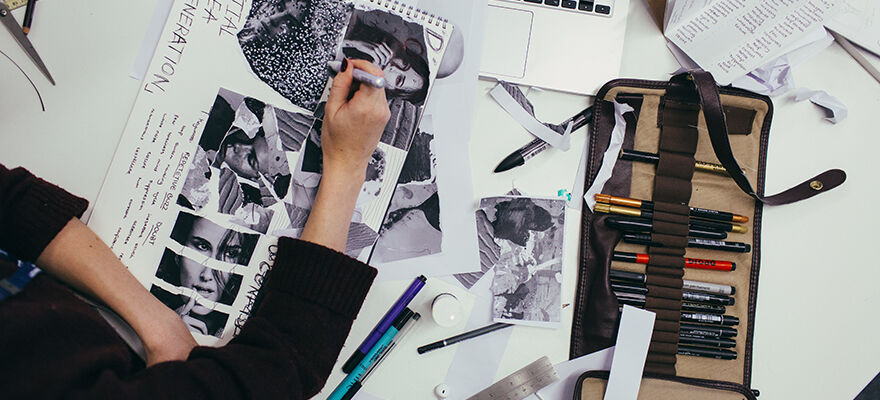We often get asked how students can prepare for their course, so to help keep you busy over summer, our Course Directors have put together a list of activities you can do to get ready for September.
Explore art in the real world
You should spend time visiting contemporary art galleries (digitally and in our post lockdown new normal) - it’s important that you look out into the world and explore the art that is happening right now - be curious, explore what you like and try to understand what you don’t like. Keep looking, make notes and be inspired.
To help you familiarise yourself with key contemporary artists and gallery spaces we’ve listed a range below, both big and small, which should give you a good start.
|
Birmingham: |
Elsewhere - UK: |
|
London: |
Elsewhere - International: |
 Try this if you're interested in Fine Art:
Try this if you're interested in Fine Art:
The theme of this project is: Being agile and keeping limber.
Attempt to make (or work on) an artwork every day
This could be big or small, complex or really simple. It could be a something you’ve found in your house, unusual material relationships, sculpture, digital collage, photograph, drawing, performance, video, gif – anything that keeps you playing, thinking and looking for new ways of understanding and arranging the world. For instance, you could:
- Take one thing, transform it and make it another e.g. Martin Creed, Work No. 88
- Look for new ways of arranging things e.g. Helen Marten – Peanuts, 2012
- Make a costume / pose / perform e.g. Anthea Hamilton – The Squashin 2018
- Collide and make collage e.g. John Stezaker, She (Film Portrait Collage) III, 2008
- Be surreal e.g. David Shrigley, I Was Dirty
- Observe / document your surroundings e.g. Richard Wentworth
 Start a sketchbook
Start a sketchbook
Make observational / experimental drawings / paintings / collages. It’s not about trying to be photo-realistic but looking, responding and trying to make sense of the world. Try to be experimental and take risks with your drawings.
Read these:
- David Bayles and Ted Orland: Art & Fear: Observations on the Perils (and Rewards) of Artmaking
- Julian Stallabrass: Contemporary Art: A Very Short Introduction
- John Berger: Ways of Seeing
- Gilda Williams: How to write about Contemporary art
- Authors: Video/Art: The First Fifty Years (Documents)
Watch these:
Try this if you're interested in Art and Design (with Creative Technologies):
The theme of this project is: Future Design
You are challenged to imagine future designs and creative solutions. We ask you to consider how the things you make might change the way people live, interact, think or care for one another and the planet.
 Finding inspiration
Finding inspiration
On Art and Design (with Creative Technologies) we draw from a wide range of influences, cultures, aesthetics and contexts. We find inspiration in many different places. It might be: a festival; a film; a game; an event; an App; a building; a book; an article; a talk; a piece of music; an exhibition etc. Attempt to create work that changes the way you interact with or see the world in response to the suggestions below. You’ll find some of these links take you to artists, designers and creative technologists and some relate specifically to your theme - Future Design.
Look at these:
- Our Visiting Professor Jason Bruges’ Studio: https://www.jasonbruges.com/
- Es Devlin’s mind blowing TED talk:https://www.ted.com/talks/es_devlin_mind_blowing_stage_sculptures_that_fuse_music_and_technology
- Kasia Molga’s Human Sensor Procession: Human Sensor
- Diffus Design’s amazing Climate Dress: Climate Dres
- Seetal Solank’s amazing Materials website: https://ma-tt-er.org/
- Black Mirror, San Junipero (Season 3, Episode 4).
- Ridley Scott’s film Blade Runner.
 Experiment with making:
Experiment with making:
- Storyboard – Draw a storyboard for an interactive experience that changes the way you interact the world.
- Assemblage - Take two things that don’t belong together and make them interact in a new way. Then take a photograph, like Martino Gamper, 100 Chairs in 100 days, 2007.
- Wearable - Make something you can wear that changes the way you interact with or see the world. Why not try out a felted crochet sensor: Instructables
- Digital - Exploit digital technology that you have access too and photograph things, film things, or scan objects to make 3D models, and try out Augmented Reality (AR) with this free app: Scaniverse
 Read these:
Read these:
- 21 Twenty One, 21 designers for twenty-first century Britain by Gareth Williams.
- Too Much World: Is the Internet Dead? By Hito Steyerl.
- Speculative everything: design, fiction, and social dreaming by Dunne and Raby.
 Try this if you're considering a Foundation Art degree
Try this if you're considering a Foundation Art degree
Using a random word generator enter the first and last letters of the following word: REJUVENATED.
Generate a new word each day and work creatively on a response that lasts between five minutes to two hours long depending on your surroundings and mood!
Anything is possible – you could film, draw, record with narrative, cook, wash, photograph, sculpt, paint etc.
You can document your results in a sketchbook, on random pieces of found papers/surfaces or on a blog – students on the course successfully use Tumblr for online sketchbooks if you would like to give it a try.
For those empty moments where you are looking for something satisfying to do, but are not sure what it is, take a look at this list of ‘things’ to motivate and inspire.
- Watch an art film
- Read CRAFTS – a magazine that’s about more than just traditional crafts!
- Take a look at It’s Nice That, a contemporary arts platform
- Learn more about figure drawing on this blog

